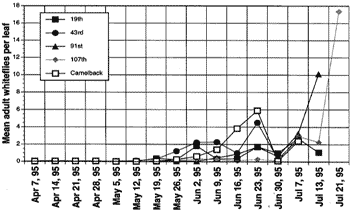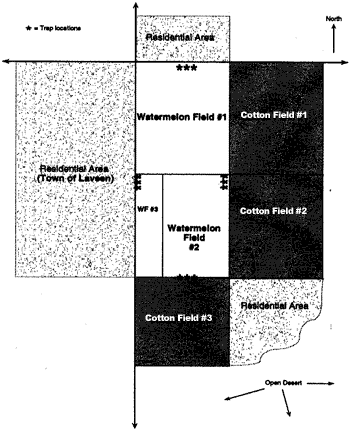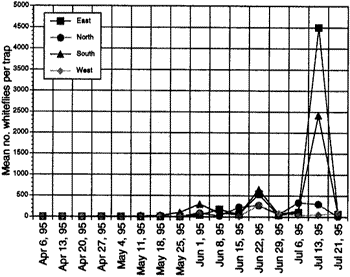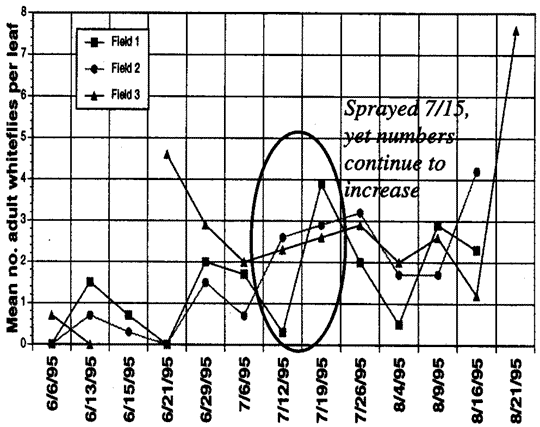Population Dynamics in Watermelon
Diehl, J., K. Umeda and P.C. Ellsworth. 2/96 (revised 5/97). Whiteflies In Arizona: Population Dynamics in Watermelon. IPM Series Number 10. Cooperative Extension, College of Agriculture and Life Sciences, University of Arizona, Tucson, Arizona.
A binomial scheme for sampling whiteflies in cantaloupes has been developed and validated by Palumbo et al. and is described in the cooperative Extension publication, IPM Series No.1, Sampling Plans and Action Thresholds for Whiteflies on Spring Melons. This sampling model is less useful for watermelons than it is for cantaloupes and other spring melons. In 1995, we sampled whiteflies in five watermelon fields within the Laveen-Tolleson Pest Control District in order to document population trends and obtain data for validating a new sampling model for watermelons. Similar data was collected by John Palumbo in Yuma. We also studied whitefly movement out of three of these watermelon fields by placing yellow sticky traps adjacent to the fields. Sampling data collected by the Laveen-Tolleson Pest Control District in adjacent cotton fields provides additional evidence of whitefly seasonal dynamics and movement between crops.
Sampling in Watermelons
Beginning 7 April and continuing until the field was disked down, we sampled whitefly populations weekly in five watermelon fields. In each field, we counted the number of adult whiteflies on the fourth leaf from the terminal on 100 plants. Five plants were selected randomly and sampled from five different locations in each of four quadrants in a field. All samples were taken in the morning, mostly between 6 and 9 a.m.
Whitefly dynamics within the five fields are summarized in the graph below. In general, whitefly populations began to increase starting in the third week of May. Insecticide applications kept populations under control through June. Large whitefly populations developed in fields which were not disked down before the second week in July.

Intercrop Whitefly Movement
Over the course of a year, whitefly populations depend on a succession of host plants. Because melons may be present as temperatures begin to heat up, they are often the first host plant on which large whitefly populations develop. Using 3 x 3 inch yellow sticky cards, we observed the timing of whitefly movement out of three watermelon fields. In each field, three traps were placed along the north, south, east and west edges of the field. Traps were placed weekly and left in the field for twenty-four hours. The map below shows the location of three cotton fields relative to one group of watermelon fields that was sampled.

This field provides an example of the potential for whiteflies to move out of melon fields when they are disked. Watermelon field #2 was disked on July 13. The following graph illustrates the number of whiteflies caught on traps surrounding the field on that day. The most whiteflies were caught on the south and east sides of the field with an average of over 4500 whiteflies caught in the east side of the field.

This large influx of whiteflies may have an adverse effect on control efforts in neighboring cotton fields. For example, whitefly populations increased in all three cotton fields adjacent to the watermelon field even though these fields were treated for whiteflies that week (see graph below). Timely disking or treatment of watermelons can limit whitefly migration before populations build up. Cross-commodity cooperation will contribute to the effectiveness of whitefly management regionally.

Issued in furtherance of Cooperative Extension work, acts of May 8 and June 30, 1914, in cooperation with the U.S. Department of Agriculture, James A. Christenson, Director Cooperative Extension, College of Agriculture and Life Sciences, The University of Arizona.
The University of Arizona is an equal opportunity, affirmative action institution. The University does not discriminate on the basis of race, color, religion, sex, national origin, age, disability, veteran status, or sexual orientation in its programs and activities.
Any products, services, or organizations that are
mentioned, shown, or indirectly implied in this web document do not imply
endorsement by The University of Arizona.
Information provided by:
Jon Diehl, Assistant in Extension, IPM
Kai Umeda, kumeda@ag.arizona.edu Agricultural Agent, Vegetables
Peter Ellsworth, peterell@ag.arizona.edu IPM Specialist
University of Arizona, Tucson, Arizona.
Material written Februrary 1996 (revised 5/97).
Vegetable Insects | Vegetable Insect Pubs | Vegetable Insect Data | Advisories | Pesticides | Photos
Home | Vegetables | All Insects
document located at: http://cals.arizona.edu/crops/vegetables/insects/wf/wfwatermelon.html
Copyright © 2001 University of Arizona,
College of Agriculture and Life Sciences
webmaster: jsjones@ag.arizona.edu